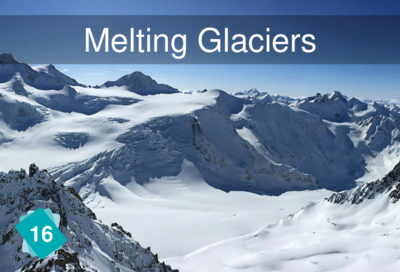En-en adult card 16 melting of glaciers
Card #16: Melting of glaciers
| Causes | Consequences | |

|
Almost all glaciers have lost mass. Hundreds of them have already disappeared.
These glaciers play a regulating role in the provision of fresh water.
Definition
A glacier is a large body of ice and snow. It forms because the snow in an area does not all melt in summer […] A glacier only moves about 50 metres (160 ft) per year. New snowfalls replace the parts that flow away[1].
The melting of a glacier will be referred to here when the total mass of ice has decreased over the period under consideration, regardless of the processes involved.
Explanation of the links
Consequences
Sea level rise A melting of 100 gigatons of ice per year is equivalent to about 0.28 mm per year of mean sea level rise[2]. Thus, 15 to 35% of sea level rise is linked by to the melting of glaciers, according the IPCC scenarios. 30% to 35% is linked to the expansion of water. The remainder is linked to the melting of the ice caps.
Freshwater Resources Melting glaciers threaten water supplies. Indeed, the relative importance of glacier melt water in summer can be considerable, contributing for example to 25% of August flows in the basins draining the European Alps, with an area of about 105 km2 and only 1% glacial cover[3].
Their disappearance could be catastrophic for cities located in valleys watered by rivers flowing down from the surrounding mountains and for freshwater fauna. Glacier meltwater also increases in importance during droughts and heat waves.
Other possible links
Consequences
River flooding It is possible, in certain circumstances of high heat, that too rapid melting of glaciers may cause flooding. But the real concern about these glaciers is that they are gradually disappearing, depriving downstream irrigation of a top-up in summer.
To go further
Observation
According to the IPCC, glaciers around the world are losing mass: about 220 Gigatons per year between 2006 and 2015[4].
Projections
In the future, by 2100, glaciers could lose around 18 ± 7% (scenario RCP2.6) or even 36 ± 11% (scenario RCP8.5) (average confidence index). These average values conceal large regional disparities: again according to the CPR8.5 scenario, up to 80% of the ice mass could disappear in areas with "small glaciers" (Central Europe, Caucasus, North Asia, Scandinavia, tropical Andes, Mexico, East Africa, Indonesia, etc.). (average confidence index). In these regions, many glaciers are very likely to disappear regardless of future GHG emissions[5] (very high confidence index).
References
- ↑ Wikipedia simple definition
- ↑ IPCC Report 2013 - Summary for Policymakers p7 (French)
- ↑ Freshwater Report 3.4.3 Glaciers, p243
- ↑ Special Report on Ocean and Cryosphere in the Context of Climate Change - Summary for Decision Makers - Observed Changes and Impacts
- ↑ Special Report on Ocean and Cryosphere in the Context of Climate Change - Summary for Decision Makers - Projected Changes and Risks